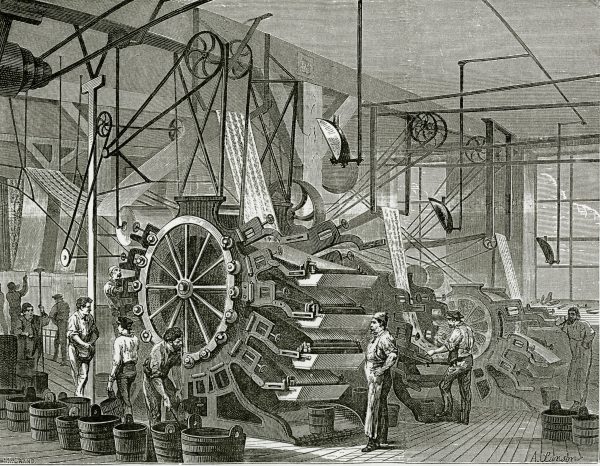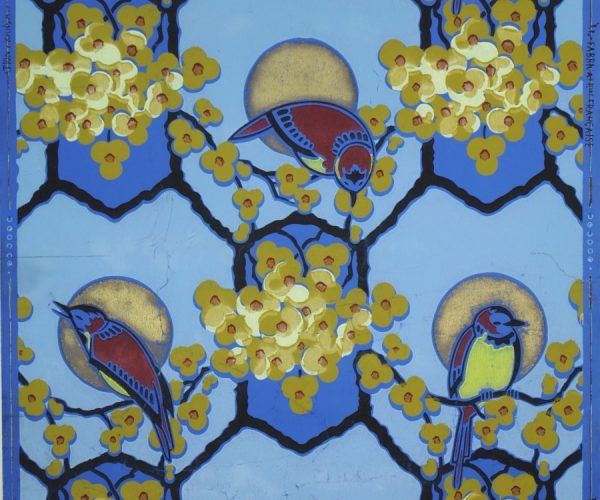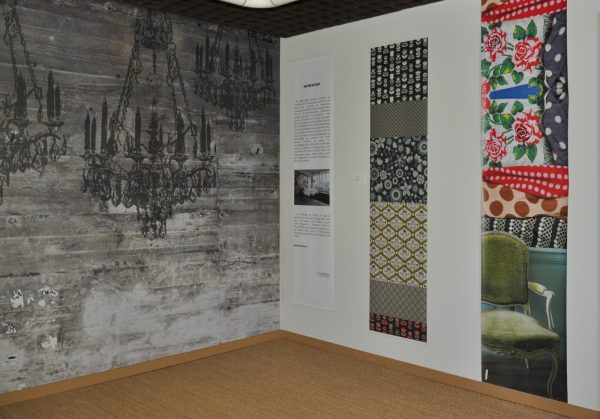
A brief history of Wallpaper
In spite of its French name, papier peint (painted paper), wallpaper is not painted! Since the 18th Century, it has been printed using a process which began as a handcraft but became industrialised following mechanisation in the 19th Century.
It is true that, originally, the paper, which had been imported from China since the 16th Century, was painted by hand. At that time, in Europe, domino papers were also being produced; these sheets of paper were block printed to obtain the outlines of a pattern and then coloured in, using a paintbrush or stencil. This paper was put to a variety of uses; firstly to decorate walls but also for decorating furniture and boxes as well as book covers.
At the beginning of the 18th Century, in England, people began to stick the sheets together to form a roll prior to printing them. This was the birth of wallpaper as we know it today.
The spread of the use of continuous paper rolls in the 1830s allowed manufacturing to become mechanised. Many printing machines were developed and they soon became steam driven. From the 1860s onwards, production could be carried out in large volumes which reduced the cost of production and resulted, at the end of the 19th Century, in wallpaper being used even in modest interiors.
Wallpaper manufacture became highly technical with manufacturers registering a large number of patents to protect their inventions and often combining several techniques to achieve special effects such as embossing, gilding and satin finishing. These procedures allowed virtually any material to be imitated, wallpaper being a past master in the art of trompe l’oeil. By the 19th Century, it could provide the perfect imitation of a profusion of plants in a conservatory, a Cordovan leather wall hanging, a lace curtain or Lyonais silk. Today, tastes have changed, but not the number of desired effects; from padding to graffiti on a concrete wall – anything is possible. Manufacturers also like to enhance the effect of the paper by adding resin beads and metallic primers. The new interest, which designers and artists have been showing in wallpaper since the early 2000s, and the enthusiasm of the general public, which is clear from all the home decorating magazines, will, we hope, usher in a new era of prosperity for wallpaper!

18e siècle
Papier dominoté
Collection privée
Avant 1830
Fabrication du rouleau
Jusqu’à l’invention du papier continu vers 1830, pour fabriquer un rouleau de papier il fallait assembler bout à bout 24 feuilles de papier, collées par leur bord les unes aux autres.
Détail montrant une marge du raboutage au verso d’un papier peint au fond brossé en noir


18e siècle
Impression à la planche – motif basique 18e siècle
Papier peint à motif répétitif, Manufacture Réveillon, référence 812, Paris, vers 1789, papier rabouté, fond mat, impression planche, 2 couleurs, Musée du Papier peint, Rixheim, France, inv. 992PP8-31
A partir du 18e siècle
Table d’impression à la planche –
Technique de fabrication du papier peint, illustration tirée de l’ouvrage de Louis Figuier, Les merveilles de l’industrie, Paris, Furne Jouvet et Cie, 1876


18e siècle
Impression à la planche
Papier peint à motif répétitif, Manufacture Jacquemart et Bénard, référence 1181, Paris, 1794-1797, papier rabouté, fond mat, impression planche, 12 couleurs, Musée du Papier peint, Rixheim, France, inv. 992PP8-9
Début 19e siècle
Planche pour l’impression de papier peint
une planche correspond à une couleur
Planche imprimant une partie des visages des trois servantes de Vénus, lé 19, décor en papier peint « Psyché et Cupidon », Manufacture Dufour, Paris, 1815, Musée du Papier peint, Rixheim, France, inv. 989PP7-1


Début 19e siècle
Impression à la planche
La maîtrise de la technique à la planche donne des effets de relief remarquable aux motifs au dessin en trompe l’oeil
Papier peint à motif répétitif, Manufacture Dufour, Paris, 1808, papier rabouté, fond mat, impression à la planche, 13 couleurs, tontisse, Musée du Papier peint, Rixheim, France, inv. 995 PP 22-11-A
A partir de 1840
Mécanisation de la fabrication du papier peint
Technique d’impression mécanique au rouleau en relief
Atelier d’impression mécanique, Manufacture Gillou et Thorailler, Paris – Illustration paru à l’occasion de l’exposition universelle de 1867 dans le rapport des commissions ouvrières, section papier peint, page11.


19e siècle
Rouleau ou cylindre d’impression de papier peint
Cylindre d’impression mécanique, graveur Süss, Autriche, âme en bois, motif cerné de cuivre et comblé de feutre, Manufacture Tapetenschmidt, édition Wiener Werkstätte, dessin d’Arthur Berger, 1913
A partir du 19e siècle
Impression mécanique traditionnelle de papier peint
Détail d’un ensemble bac à couleur, feutre et rouleau relief
Machine à imprimer 12 couleurs avec des rouleaux en relief, provenant des anciens ateliers de la manufacture J. Zuber & Cie, elle a été achetée en 1877 à l’entreprise Waldron & Co, à New Brunswick (New Jersey, USA). Actuellement dans la salle technique du Musée du Papier peint.


Fin 19e siècle
Papier peint mécanique simple
Papier peint à motif répétitif, Manufacture Inconnue, vers 1880, papier continu teinté, sans fond, impression mécanique, rouleau en relief, 3 couleurs, Musée du Papier peint, Rixheim, France, inv.2013.17.25
Fin 19e siècle
Papier peint mécanique 24 couleurs
Papier peint évoquant l'exposition Universelle de Paris de 1878, Manufacture Roger, Moineau (60), 1878, papier continu, sans fond, impression mécanique 24 couleurs, Musée du Papier peint, Rixheim, France, inv. 989 PP 5-8-A


Fin 19e siècle
Papier peint avec gaufrage
Papier peint à motif répétitif, Manufacture Heinrich Engelhard Tapetenfabrik, référence 4337 23, Allemagne, fin 19e siècle, carton, fond mat, impression à la planche une couleur, gaufrage au balancier, vernis patiné, Musée du Papier peint, Rixheim, France, inv. 979PP2-39
Fin 19e siècle
Style Art Nouveau
Frise de papier peint, Manufacture Inconnue, vers 1900, papier continu, fond mat, impression à la planche 4 couleurs, Musée du Papier peint, Rixheim, France, inv.987PC249


Début 20e siècle
Style Art Déco
Page d’album, papier peint impression mécanique et lithographie publicitaire, Manufacture Etablissement Motel Gaillard, collection 1938-1939, Musée du Papier peint, Rixheim, France, inv. 2010PP11-3
Début 20e siècle
Style Art Déco
Papier peint à motif répétitif, Manufacture Isidore Leroy, Saint-Fargeau-Ponthierry (77), années 1930, papier continu, fond mat, impression mécanique, 6 couleurs, Musée du Papier peint, Rixheim, France, inv. 2000PP 26-1


20e siècle
Mouvement Moderne
Papier peint à motif répétitif, Manufacture Rasch, référence bo28, Osnabrück, Allemagne, dessinateur Atelier de l'école du Bauhaus, Dessau,1932, Papier continu, fond mat, impression mécanique, 2 couleurs, gaufrage , Musée du papier peint, Rixheim, France, inv. 2011.9.243
Milieu 20e siècle
Développement de l'impression en héliographie
Papier peint à motif répétitif, Manufacture Paul Gruin S.A, réf.2842, Paris, années 1950-1960,
papier continu, fond mat, impression mécanique, héliographie, 11 couleurs, gaufrage, Musée du Papier peint, Rixheim, France, inv. 2012.2.9


Milieu 20e siècle
Publicité
Publicité présente dans un album de revendeur, PB décors, collection 1956, Champigny-sur-Marne, Musée du Papier peint, Rixheim, France, inv. 2010PP15
Milieu 20e siècle
Papier peint fantaisie
Papier peint à motif répétitif, Manufacture Inconnue, Royaume-Uni, années 1950-1960, papier continu, fond mat, impression mécanique, 12 couleurs, Musée du Papier peint, Rixheim, France, inv.2011.29.2


Fin 20e siècle
Chaîne d'impression en héliographie
Publicité pour un constructeur de machine d’impression en héliographie, Holweg à Strasbourg, Revue française du papier peint, n°9, 1969
Fin 20e siècle
Papier peint pré-encollé
Publicité pour les papiers peints de la manufacture Follot, Paris, parue page 32 de la revue « Bricolage, décor de la maison », n° 64, février 1972.


Fin 20e siècle
Style Pop
Papier peint à motif répétitif, manufacture Anonyme, années 1970, papier continu, impression mécanique hélio, gaufrage, Musée du Papier peint, Rixheim, France, inv.2002 PP 21-8-A
Fin 20e siècle
Style Pop
Page d’album, collection 1973-1974 du revendeur Ouest Papier Peint, Nantes, papier peint vinyl et mise en scène publicitaire, Manufacture Mayfair, Royaume-Uni, Musée du Papier peint, Rixheim, France, inv. 997PP12-19


Fin 20e siècle
Motif Années 1990
Papier peint à motif répétitif, Manufacture Inconnue, vers 1988, papier continu, impression mécanique, héliographie, gaufrage, Musée du Papier peint, Rixheim, France, inv. 996PP 13-81
Fin 20e siècle
Teintes Années 1990
Pages d’album, collection 1991, «Les enfants, Pile ou face…, Face enfants, Pile Ados», Manufacture Société Française des papiers peints, Balagny-sur-Thérain (60), Musée du Papier peint, Rixheim, inv. 990PP20-3


A partir des années 1970-1980
Vinyl à relief expansé
Détail, papier peint à motif répétitif, Manufacture Inconnue, France, années 1980-1990, papier continu, fond mat, impression mécanique, héliographie et sérigraphie rotative, vinyl à relief expansé, Musée du Papier peint, Rixheim, France, inv.2012.13.6
Début 21e siècle
Impression numérique
Machine d’impression numérique, années 2010


Début 21e siècle
Papiers peints imprimés en numérique
Papiers peints imprimés en numérique, à gauche, décor panoramique de l’entreprise InCréation, Paris et à droite deux motifs édités par The Collection, Paris, design Mini Labo et Aurélie Mathigot, présentés dans l’exposition à Rixheim “Made in France, le papier peint en 2015”